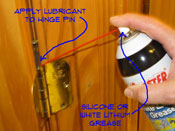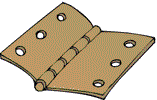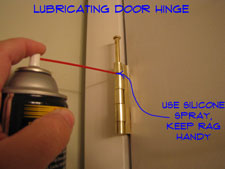Doors
How To Repair a Pocket Door
This article will cover the topics related to fixing and repairing pocket doors.
See also, pocket door hardware, installing a pocket door.
Repairing Exterior Doors
Repairing exterior doors is a common need! There is no need to install a new door when things go wrong, instead you can repair you existing door and get it working like new.
Locks, deadbolts, weatherstripping and adjustments are all important features of an exterior door. These items and wear out, break and get out of adjustment. With a few tools and a little know how, you can repair these items.
Not sure if this is your problem? See the article 'Fixing and Repairing Doors' for a complete listing of all of the door topics.
Most home have a front door and other doors that lead to the outside. One key issue with this type of door is security. The door and hardware protect us from unwanted visitors. Keeping the hardware working properly is an important safety feature. Another issue is the weather on the outside of our home. We need our exterior doors to keep us both warm in the winter and cool in the summer. Weatherstripping and thresholds accomplish this task.
Below you will find links to articles that discuss key topics about exterior doors. Try to find the article that best describes your problem. The articles will provide you with useful information and how to knowledge on repairing this type of door.
Repairing Exterior Doors - Finding Help
The introduction to each series of articles has an evaluation section. This section will help you decide if you want to repair your own exterior doors. The "What Can You Save?"and "How Hard Could It Be?" sections give you a quick overview of the repair. This will help you decide if it is using common sense or good judgment to make the repair yourself.
The "Check the Simple Things First" section will clue you in to easy, exterior door fixes to check for. The 'Simple Fixes' usually take five minutes or less. In an effort to warn you about what you are in for, there is the "What Can Go Wrong" section. Use this section to benefit from the experience of others, without the discomfort.
Entry Door Repair
Entrance doors take a lot of abuse, both from the weather and from constant use. Bringing things in and out of the home can damage the door. Heat, cold, snow and rain will all take a toll on the functioning of an exterior door.
There are three common things that will need attention. (1) The door itself will get out of alignment and need adjustment. (2) The hardware will wear out or start to malfunction. (3) The weatherstriping will fail and not keep out the elements. Follow this link for a discussion on these issues.
Rusty Hinges
The door is supported in the frame by hinges. Usually three or four on an exterior door. Hinges can rust and start to bind, making it difficult to close the door. In addition, they will make a lot of noise. What can you do with them? Lubrication or replacement are the two likely choices. Find out what it is that you need.
Screen Door Repair
Screen doors or 'Storm' doors as they are sometimes called are an added level of protection for a home. They can allow air into the house during moderate seasons. They also keep out the elements and protect the main door. These doors are installed and operate differently than traditional doors. This article discusses the problems and solutions.
Exterior Door Hardware
Entrance doors will often have both a door lock and a deadbolt. When they are bought as a set these locks use the same key. Lubrication and alignment are critical with door locks. Can door locks and deadbolts be repaired? Yes they can. At times they will need to be replaced. This series of articles will provide the needed skills.
How To Lubricate Door Hinges
Before you start lubricating door hinges, you want to have an old rag handy. Be careful with how much spray or grease you apply. You don't need a lot. More is not better in this situation. Wipe up any excess with the rag quickly before it runs and gets on something.
For related topics, see the articles 'Door Hinge Repairs', 'Replacing Door Hinges', 'Adjusting Door Hinges' and 'How To Fix a Door'.
It is best to remove the pin to lubricate a door hinge. You can use a small screwdriver and a hammer to tap the pin out, usually from the bottom of the hinge. Keep the door closed and do one hinge at a time. This way the door will stay supported.
Spray a little silicone spray on the joints in the two hinge leaves where they rub together. Spray a coating onto the pin and tap it back into the hinge. Add a little more spray when you are about half way. Finish tapping the pin into place. Your squeaky door hinge should soon be history.
Repeat this process for the other hinges on the door. The procedure with grease is similar. Coat the pin with a thin layer of grease. Put a small dab of grease on the end and tap the pin back into place.
After you have taken care of all the hinges, open the door. Move it back and forth several times to work the lubricant in. Hopefully, the squeak is gone. Repeat the process if the squeak persists. You want to be sparing with the lubricant, but not too sparing.
Oiling Door Hinges
 The simplest fix for this problem is oiling door hinges. This is a fairly simple task. The only material you need is five dollar (or less) can of silicone spray. There are a few things to concern yourself with. The first is the potential mess. The other is the lubricant that you decide on.
The simplest fix for this problem is oiling door hinges. This is a fairly simple task. The only material you need is five dollar (or less) can of silicone spray. There are a few things to concern yourself with. The first is the potential mess. The other is the lubricant that you decide on.
Graphite is often recommended for door hardware. It is dry and will not get your keys all oily. In moderation, graphite is a great product and will free up sticky locks. For hinges there are some concerns. The black dry powder can get on surfaces like painted walls and carpet and stain them. This could be a real problem. The hinge works, but the carpet is ruined.
For oiling door hinges, silicone spray or white lithium grease is probably the best choice. Silicone is the easiest, but does not last as long as the grease. When use properly, the mess is minimal. If you decide to use graphite, be careful.
Remove the hinge pins from the hinge one at a time. Apply the lubricant and put the pin back in. When the hinges are lubricated, you should work the door back and forth to work the lubricant in. Repeat if the squeaks or stiffness is persistent. For more information see the articles, 'Squeaky Door Hinges' and 'Fixing Rusty Hinges', for more information on hinge lubrication issues.
WARNING!! Only Remove One Hinge at a Time. The Door Will Fall!!! WARNING!!!
Lubricating a Rusty Hinge
 Lubricating a rusty hinge is a good choice when the hinge is still working. Oil will loosen it and quiet it down with a little effort.
Lubricating a rusty hinge is a good choice when the hinge is still working. Oil will loosen it and quiet it down with a little effort.
When a rusty hinge has deep rust, you may want to start by soaking the hinge with penetrating oil. Use a good quality penetrating oil. Apply the oil liberally, without getting it everywhere. Keep a rag handy to wipe up any excess. Allow the oil to soak in before you try working the hinge. You may want to repeat this step a few times with a badly damaged hinge.
After the penetrating oil has freed up the hinge, you can lubricate it. Use a silicone spray or white lithium grease for this task. Keep in mind that an old badly rusted hinge may need repeated treatments.
Lubricating a rusty hinge is easier when you remove the pin. Not all pins are removable, especially on older doors. When this happens, use spray silicone or spray penetrating oil and try to get it in every crevice of the hinge. Work the door back and forth to work the lubricant down into the hinge.
The age and appearance of the rusty hinge may make you decide to replace it. The easiest replacement job is when you have new hinges that are the same size as the old ones. You can replace one hinge at time without taking the door off. Unfortunately, finding replacements for older hinges is difficult. You may need to go online or go to a specialty hardware store. Cost will go up for hinges that are restoration quality.
One other option would be to fit the door for a newer style hinge. This will require some carpentry skills and may be beyond the ability of the average homeowner. You need to take the door off and change the mortises in the door and frame.
Summary
For related topics, see the articles 'Door Hinge Repairs', 'Replacing Door Hinges', 'Adjusting Door Hinges' and 'How To Fix a Door'.
Purchasing Door Hinge Lubricant
A lot of people recommend graphite for squeaky door hinges. Does graphite work? Yes it does, it will stop the squeak. The drawback is that graphite is a black powder and it can make quite a mess if it gets on something like your carpet or painted walls. Graphite can work its way out of the hinge and stain things. So for door hinges, I do not recommend graphite.
Not sure if this is the right problem? See the articles 'Troubleshooting Door Problems' and 'Fixing Door Hinges' for more information.
The two best choices are a silicone spray or white lithium grease. My preference it the silicone spray. It is colorless and can be used sparingly. You may have to use it more often than grease, but it is less messy and a little easier to use. Purchase a spray can of silicone spray, one that is suitable for door hardware. It should have one of those long red tubes taped to the side of the can.
You can also use white lithium grease. You will have to take the pin out of the hinge to use it. You will also have to watch for excess seeping out of the hinge for a couple of days. Other things like three in one oil and machine oil will also work. Caution needs to be exercised when using oils, don't use to much.
How To Fix Squeaky Door Hinges
 Squeaky door hinges are right up there with dripping faucets on the irritation scale. The squeak develops over time until you can't stand it and something needs to be done. Dealing with a noisy hinge should be an easy thing to fix. Some suitable lubricant is all you need.
Squeaky door hinges are right up there with dripping faucets on the irritation scale. The squeak develops over time until you can't stand it and something needs to be done. Dealing with a noisy hinge should be an easy thing to fix. Some suitable lubricant is all you need.
For related information see 'Troubleshooting Door Problems', 'Repairing Door Hinges', 'Adjusting Interior Doors' and 'How To Adjust Exterior Doors'.
Door hinges are a moving part. They are made of two pieces of flat metal that have notched tabs of metal. These tabs interlock with the tabs on the other side of the hinge and are wrapped around a pin that hold them together. When the door opens and closes, the plates rub against each other and against the pin. When the grease or graphite wears away you will get metal rubbing against metal. That's when the squeaks start.
There is no point in putting off this repair. It should only take a few minutes. In five minutes or less you can quit cringing every time someone opens the door.
Fixing Squeaky Door Hinges - Information
What Can You Save?
A service man will likely charge you $50 to $75 to take care of this problem. This is mostly due to the fact that he has to spend time driving there.
How Hard Could It Be?
Fixing squeaky door hinges is pretty simple and does not take much effort.
Check the Simple Things!
This is already the simplest repair you can make with a door hinge. There is not simpler task to perform.
What Can Go Wrong?
Getting oil all over the door and wall is probably the biggest problem you will face. Use the lubricant sparingly. Always keep a rag handy when you are using oil and other lubricants.
Tight Squeaking Door Hinges
 Tight squeaking door hinges are pretty aggravating. Most of the time, you can fix them with a little oil.
Tight squeaking door hinges are pretty aggravating. Most of the time, you can fix them with a little oil.
Try lubricating the hinges first. Use a recommended silicone spray, oil or grease made for this purpose. You can use a punch and a hammer to drive the pin out, (usually from the bottom of the hinge up, unless it was installed upside down). For doors with only two hinges, leave the pins in about halfway. Keep a rag handy and apply the lubricant sparingly, but in enough quantity to solve the problem. Watch for drips and oozing. Replace the pin and open and close the door several times, working the lubricant in.
Are the hinges rusted or painted beyond what a little silicone spray can take care of? Replacing them is easy if you get the same size. A door with only two hinges will need to be taken off before the hinges can be changed. Open the door and put something under the bottom to support it (a block of wood, book, not your toe). Unscrew the bottom hinge first and then the top. Hang onto the door when you release the last screw. For solid core or wood doors you may want to get some help when you take the door off. Lean the door against the wall and finish removing the hinges.
Obtain enough replacement hinges for the door, usually three. Change them one at a time. You may need a chisel or knife to get them loose if they have been painted in place over time. Replacing the hinges, even if you do them one at a time, is repairing a prehung interior door. Well done!
Loosening Tight Door Hinges
 Before you consider replacing the hinges, try loosening tight door hinges with lubricant. Use a recommended silicone spray, oil or grease made for this purpose. You can use a punch and a hammer to drive the pin out, (usually from the bottom of the hinge up, unless it was installed upside down).
Before you consider replacing the hinges, try loosening tight door hinges with lubricant. Use a recommended silicone spray, oil or grease made for this purpose. You can use a punch and a hammer to drive the pin out, (usually from the bottom of the hinge up, unless it was installed upside down).
Keep a rag handy and apply the lubricant sparingly, but in enough quantity to solve the problem. Watch for drips and oozing. Replace the pin and open and close the door several times, working the lubricant in.
One or all of the hinges could need attention. Only take one pin out at a time. Taking out two or three will cause the door to fall and possibly damage it. Only take all the pins out when you are prepared to remove the door. Loosening tight door hinges by lubricating the pins may be a maintenance item that needs to be repeated periodically.
Are the hinges rusted or painted beyond what a little silicone spray can take care of? Replacing them is easy if you get the same size. Remove the middle hinge and take it with you to match up at the hardware store. Obtain enough replacement hinges for the door, usually three.
Change them one at a time. You may need a chisel or knife to get them loose if they have been painted in place over time. Replacing the hinges, even if you do them one at a time qualifies as a successful entry door repair.
Troubleshooting Squeaking Door Hinges
In Step One the article 'Purchasing Door Hinge Lubricant', helped you to make sure that you get the right oil or grease for your door hinges. Most home supply or hardware stores have what you need.
'Lubricating Door Hinges' is the article that covers the actual oiling of the door hinges. It is a pretty easy job, when you set aside the mess.
Sometimes the door is out of adjustment and causing the door to bind. When this happens, oil alone may not solve the problem. See the article 'How To Adjust Door Hinges' for information and instructions on this repair.
Summary
Fixing a squeaky door hinge should not have been too much trouble for you. You have to take the pins out to apply the lubricant. You put them back in and that should take care of the problem. Is your door quiet now? Good, you are done with this project.
If you are a homeowner you have other projects you need to attend to. Since this one was so easy you are probably inspired to attempt something else.


